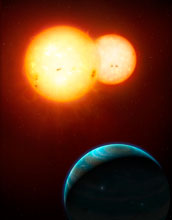Multimedia Gallery
Artistic rendition of Kepler-35, where a Saturn-size planet orbits a pair of Sun-size stars.
This is an artist's rendition of the Kepler-35 planet system, in which a Saturn-size planet orbits a pair of stars. The larger star is similar to the size of the Sun, while the smaller star is 79% of the Sun's radius.
The stars orbit and eclipse each other every 21 days, but the eclipses do not occur exactly periodically. This variation in the times of the eclipses motivated the search for the planet, which was discovered to transit the stars as it orbits the pair every 131 days. Similar events led to the discovery of the planet Kepler-34. The discovery of these two new systems establishes a new class of "circumbinary" planets and suggests there are many millions of such giant planets in our galaxy.
Credit: Mark A. Garlick / space-art.co.uk
See other images like this on your iPhone or iPad download NSF Science Zone on the Apple App Store.
Images credited to the National Science Foundation, a federal agency, are in the public domain. The images were created by employees of the United States Government as part of their official duties or prepared by contractors as "works for hire" for NSF. You may freely use NSF-credited images and, at your discretion, credit NSF with a "Courtesy: National Science Foundation" notation.
Additional information about general usage can be found in Conditions.
Also Available:
Download the high-resolution JPG version of the image. (4 MB)
Use your mouse to right-click (Mac users may need to Ctrl-click) the link above and choose the option that will save the file or target to your computer.
Related story: New Class of Planets, Clues to Supernova Origins Announced



